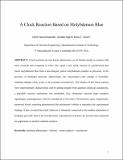A Clock Reaction Based on Molybdenum Blue
Author(s)
Neuenschwander, Ulrich; Negron, Arnaldo; Jensen, Klavs F.
DownloadJensen_A clock with SI.pdf (825.1Kb)
PUBLISHER_POLICY
Publisher Policy
Article is made available in accordance with the publisher's policy and may be subject to US copyright law. Please refer to the publisher's site for terms of use.
Terms of use
Metadata
Show full item recordAbstract
Clock reactions are rare kinetic phenomena, so far limited mostly to systems with ionic oxoacids and oxoanions in water. We report a new clock reaction in cyclohexanol that forms molybdenum blue from a noncharged, yellow molybdenum complex as precursor, in the presence of hydrogen peroxide. Interestingly, the concomitant color change is reversible, enabling multiple clock cycles to be executed consecutively. The kinetics of the clock reaction were experimentally characterized, and by adding insights from quantum chemical calculations, a plausible reaction mechanism was postulated. Key elementary reaction steps comprise sigmatropic rearrangements with five-membered or bicyclo[3.1.0] transition states. Importantly, numerical kinetic modeling demonstrated the mechanism’s ability to reproduce the experimental findings. It also revealed that clock behavior is intimately connected to the sudden exhaustion of hydrogen peroxide. Due to the stoichiometric coproduction of ketone, the reaction bears potential for application in alcohol oxidation catalysis.
Date issued
2013-05Department
Massachusetts Institute of Technology. Department of Chemical EngineeringJournal
The Journal of Physical Chemistry A
Publisher
American Chemical Society (ACS)
Citation
Neuenschwander, Ulrich, Arnaldo Negron, and Klavs F. Jensen. “A Clock Reaction Based on Molybdenum Blue.” The Journal of Physical Chemistry A 117, no. 21 (May 30, 2013): 4343–4351.
Version: Author's final manuscript
ISSN
1089-5639
1520-5215